Anisotropic microrheological properties of chain-forming magnetic fluids
Alenka
Mertelj
*ab,
Andraž
Rešetič
a,
Sašo
Gyergyek
a,
Darko
Makovec
a and
Martin
Čopič
ab
aJ. Stefan Institute, Jamova cesta 39, SI-1001, Ljubljana, Slovenia. E-mail: alenka.mertelj@ijs.si; Fax: +386 1477 3998; Tel: +386 1477 3283
bDepartment of Physics, University of Ljubljana, SI-1000, Ljubljana, Slovenia
First published on 12th October 2010
Abstract
In an external magnetic field, magnetic colloids transform from an isotropic fluid to an anisotropic viscoelastic material. Using passive microrheology, we measured the microrheological properties of a magnetic fluid as a function of direction and magnitude of external magnetic field. The effective microviscosity strongly depends on the magnitude of the external field, while it is almost independent of its direction. The measured effective storage modulus varies significantly within the sample and depends both on the direction and the magnitude of the external magnetic field. It vanishes in a zero field, while in a non-zero field it is larger by a factor of 2 to 4 in the direction along the field than perpendicular to it. The non-zero value of the storage modulus, which indicates the formation of a viscoelastic fluid, appears at magnetic fields at which the dynamic light scattering experiments reveal the formation of elongated structures.
Introduction
Magnetic colloids,1 which consist of magnetic or superparamagnetic particles in a carrier liquid, are usually prepared so that they are stable in the absence of an external field. In ferrofluids, which are made of single-domain magnetic nanoparticles in a carrier liquid, magnetic dipolar interaction between the particles is already present in the absence of the field and in concentrated samples small chains or aggregates form. External magnetic fields enhance the dipolar interaction and, if the dipolar interaction between the particles in contact exceeds the thermal energy, kBT, the particles form chains or more complex elongated structures. In the colloids of superparamagnetic particles, the magnetic interaction appears only when the magnetic field is applied. The superparamagnetic particles are mostly composite particles, usually made of ferromagnetic nanoparticles in a nonmagnetic polymer and the carrier liquid is water. Their advantage is larger variability of surface chemistry in an aqueous environment, that makes them suitable for numerous applications (e.g.magnetic separation, DNA separation, water purification, biomedical applications etc.).1Magnetic colloids show interesting external magnetic field-dependent rheological properties,1–3 which have been studied experimentally and theoretically. Most of the studies were focused on the magnetoviscous effect, i.e., the dependence of the ferrofluid viscosity on the magnetic field. The viscosity in a magnetic fluid increases with increasing magnetic field, the increase of viscosity is large for low shear rates, while for high shear rates it is relatively small. While the macroscopic magnetoviscous effect has been extensively studied experimentally in the direction perpendicular to the magnetic field, to our knowledge only in one experiment has the anisotropy of magnetoviscosity been measured.4 It has been shown that the viscosity in some magnetic fluids is larger in the direction parallel to the external magnetic field than in the perpendicular direction. The formation of chains of magnetic particles in the external field has been shown to be the most important process leading to the large increase of viscosity. The rotational motion of the chains is suppressed by the external field and this causes the increase of the viscosity5,6 and, as theory predicts, also its anisotropy.7,8
An important feature of chain-forming ferrofluids that exhibit a large magnetoviscous effect is their polydispersity. While the average size of the nanoparticles is small and consequently also the average magnetic interaction between the particles is small, the polydisperse magnetic colloids show an increase in magnetoviscosity that can be an order of magnitude larger than expected from the theory that takes into account only the average interaction. The reason is that in such an average description, the contribution of few larger particles, between which the magnetic interaction already at small fields, exceeds the thermal energy and form chains, is neglected. The hydrodynamic theory of polydispersed chain-forming ferrofluids has been proposed8 in which different timescales are used for the description of the ferrofluid dynamics, fast relaxation times correspond to the relaxation of magnetization due to the small particles that do not form chains, while a much slower relaxation time accounts for the relaxation of the magnetization that comes from the chains. This theory compares well with the shear thinning experiments, in which the shear is perpendicular to the field, it also predicts an anisotropy of the shear-dependent viscosity, but to our knowledge there were no experiments performed in the parallel geometry up to date.
The yield stress, i.e. the maximum deformation that a ferrofluid can carry before it flows, has also been measured for the case when the flow is in the direction perpendicular to the field and it was observed only in chain-forming magnetic fluids.9 To the best of our knowledge, no measurements of anisotropy of yield stress have been reported up to now. The existence of yield stress proves that the chain-forming magnetic fluids in an external magnetic field form a kind of a gel structure. The gel-like behavior of chain-forming magnetic colloids have also been observed in the dynamic light scattering (DLS) experiments.10 Those experiments have shown the anomalous diffusion behavior, typical for systems close to the phase transition to the dynamically arrested state, and a pronounced difference in the nature of the diffusive dynamics in the direction along and perpendicular to the direction of the external magnetic field. Molecular dynamics simulations have shown that in the absence of the external field, slightly elongated dipolar colloids form chains and at lower temperatures undergo a kinetic transition to a dynamically arrested state.11
In particle tracking microrheology,12 the motion of micron-sized probe particles is tracked to derive the rheological properties. In the experiment one can either follow the thermal motion of the probe particle, which is called passive microrheology, or the probe particle can be driven by an external force and its response is measured, which is called active microrheology. In passive microrheology local storage and loss moduli in an isotropic viscoelastic sample can be obtained from mean square displacement (MSD) using a generalized Stokes–Einstein relation.13 In the more controlled, active microrheology, a particle is driven by oscillating optical tweezers, and the response, the amplitude and the phase of the particle position is measured. Unfortunately, active microrheology is not suitable for magnetic fluids, since the nanoparticles, the constituents of the magnetic fluid, also get trapped by the optical tweezers.
In this paper, microrheological experiments in magnetic colloids that consist of nano-sized composite particles and their dependence on the magnitude and direction of the external magnetic field are presented. Our experiments fill the gap in experimental evidence of anisotropic rheological properties of the magnetic colloids. The structural changes in the colloid were also studied by the dynamic light scattering (DLS). The experiments and their results are described in the Experimental, which is followed by the Discussion and Conclusions.
Experimental
The magnetic colloid used in our experiments consists of 8 wt% composite nanoparticles in water. The composite particles containing high concentrations of maghemite nanoparticles dispersed in polymethyl methacrylate (PMMA) were prepared using miniemulsion polymerization of the monomer in the presence of the nanoparticles. The preparation is described elsewhere.14 The particles consist of single-domain maghemite nanoparticles with an average radius of 5.5 nm and standard deviation of 2 nm in a PMMA matrix. They have a saturation magnetization of 27 emu g−1, and a magnetic susceptibility, χp, at small fields of 0.4 (SI units). The size distribution of composite particles was measured using DLS in dilute suspension and the number distribution can be approximated by log–normal distribution with an average hydrodynamic radius of 13 ± 1 nm and standard deviation of 3 nm (Fig. 1). Sodium dodecyl sulfate (SDS) is used as a surfactant.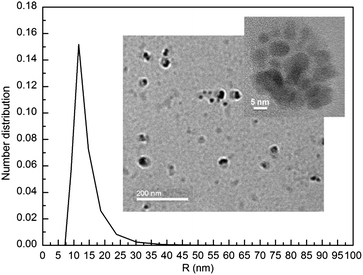 | ||
| Fig. 1 The number distribution function of composite nanoparticles measured using DLS. The insets are TEM images showing the particles. | ||
The samples were centrifuged prior to use to remove larger particles or aggregates. Such magnetic colloid resembles a ferrofluid, the particles are small, the colloid is stable and, magnetic interaction between the particles is of the order of the thermal energy, kBT. The main difference is that the composite particles consist of several (typically 2–10) single domain particles, so they behave as superparamagnetic particles and changing the magnitude of the magnetic field is equivalent to changing the interaction parameter
 | (1) |
In the magnetic colloid, a small amount of monodispersed polystyrene particles (Bangs Laboratories, Inc.) with Rp = 1.44 μm and standard deviation 0.14 μm were added as probe tracers. The sample was then sealed between two parallel glass plates. The thickness of the cell was 50 μm. The direction of the magnetic field of the home-made electromagnet was parallel to the glass plates. The field gradient in the observation area was 0.04 T m−1 at a magnetic field of 27 mT. At this value of the gradient, the magnetic forces on the particles are much smaller than the thermal ones.
Particle tracking microscopy was used to follow the thermal motion of the probe particles as a function of the external magnetic field. From the 2D particle tracks, the time dependence of the mean square displacements (MSDs) in the direction along and perpendicular to the external field were calculated. In the absence of the external field, the MSDs are linear and independent of direction. Already in moderate fields the MSDs become non-linear and there is a significant difference between the MSD along and perpendicular to the direction of the external field, as one can clearly see in Fig. 2, where tracks and corresponding MSDs are shown. While in the absence of the field the difference between the MSDs for different probe particles can be attributed to the size difference of the probe particles, in the magnetic field the difference becomes much larger. It is typical of gels that the microrheological properties depend on the position of the probe particle and in general differ from the macrorheological properties.15 For each field we have measured tracks for 10 different probe particles and for each particle we performed 4 measurements, from which the average MSD of a particle was obtained. We chose particles that were in the middle of the cell and were far away from other particles, so that there was no interaction between the probe particles. Before conducting the measurements, the system was left to stabilize for an hour.
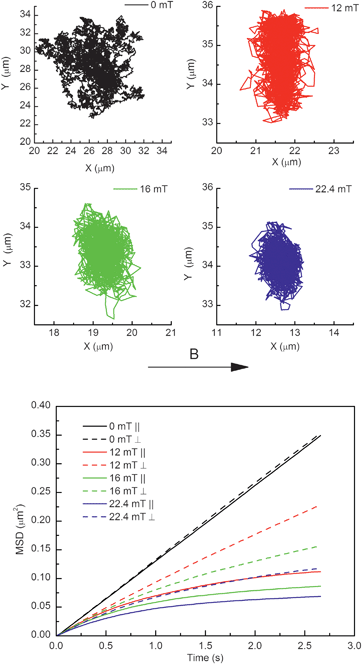 | ||
| Fig. 2 (a) Traces and (b) the corresponding MSDs of a probe particle in a magnetic colloid for different magnitudes of external field. The direction of the external field is in (a) along the x-axis. | ||
First we analyzed the MSDs using a method developed by Mason.13 The obtained frequency dependence of storage and loss moduli in the frequency range of our measurements were consistent with a simple model for a Kelvin–Voigt material. So, we have fitted the MSDs with the model for the Kelvin–Voigt material, i.e., the spherical probe particle is treated as a harmonically-bound Brownian particle with MSD13
 | (2) |
In the case of an isotropic material, further analysis would be straightforward, since there is only one shear viscosity coefficient and one storage modulus, G′. In anisotropic materials the situation is more complex. In materials with uniaxial symmetry there are 5 independent viscosity coefficients and, similarly, there are also 5 independent elastic constants. In our microrheological experiment, the viscoelastic properties in only two directions are measured, yielding two pairs of data. Two effective storage moduli G′ and two diffusion constants, which give two effective viscosity coefficients, can be found from the MSD fits. The two diffusion constants, shown in Fig. 3, decrease with increasing magnetic field, i.e., the effective viscosities increase with the field, as is typical for magnetoviscosity. Within experimental error there is no anisotropy in the diffusion constant. The situation is different for the storage moduli shown in Fig. 4. The variation of the measured effective shear modulus for different probe particles is large (the variations are typically of an order of magnitude), but the shear modulus in the direction of the field is consistently larger by a factor of 2 to 4 than in perpendicular direction.
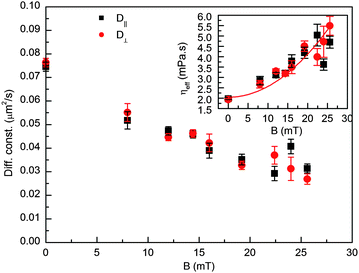 | ||
| Fig. 3 The diffusion constant of probe particles along and perpendicular to the external magnetic field as a function of magnitude of the external field. Inset: the corresponding effective viscosities. The line represents the quadratic fit (see text). | ||
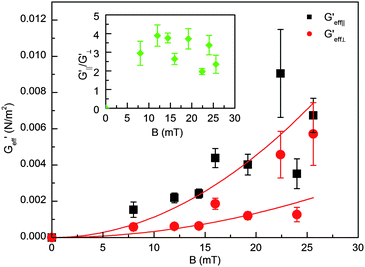 | ||
| Fig. 4 The effective storage moduli in directions parallel and perpendicular to the field as functions of the magnitude of the external magnetic field. Inset: the ratio between the storage moduli parallel and perpendicular to the external field. | ||
In an external field we observed a few larger chains of approximate length 10 μm, which sediment, and more barely visible chains of length of a few μm that exhibit thermal fluctuations confined to some position.
We also followed the process of chain formation in an external field by the DLS in samples without probe particles. In our experiments we used a standard photon correlation setup using a laser with a wavelength of 532 nm, and an ALV-6010/160 correlator to obtain the autocorrelation functions of the scattered light intensity. The intensity of the laser beam was low and the measured correlation function did not depend on the intensity, so we conclude that no heating effects due to absorption were present in our measurements. The direction of the external magnetic field and the scattering wavevector were in all of our measurements in the plane of the sample, the scattering wavevector was either parallel or perpendicular to the magnetic field. The direction of the gravity was in the plane of the sample perpendicular to the scattering vector. The polarizations of the incoming and scattered light were vertical, i.e., either parallel or perpendicular to the magnetic field.
There was no measurable signal in the depolarized scattering in the absence of and in the applied external magnetic field indicating that the scattering objects are optically isotropic in the absence of the field and in the external magnetic field the orientational motion of elongated objects was suppressed. The dynamically scattered intensity in the direction perpendicular to the field increases with the field by about 25%, while along the field it decreases by about the same amount, which indicates that part of the signal comes from the elongated objects that are oriented along the magnetic field. In the autocorrelation function two distinct relaxation processes are present, the fast one can be attributed to the diffusion of single particles and the slow one to the diffusive motion of the chains of the particles, which are oriented in the direction of the external field. We fitted the electric field autocorrelation function with a sum of a single exponential for a fast relaxation process and a stretched exponential function for a slow process. Already in a zero field, the autocorrelation function cannot be fitted with only one single or one stretched exponential function due to the polydispersity of the sample, so we fitted it with the sum of both. The single exponential function is due to small particles, the number of which prevails, while the stretched exponential function accounts for the larger polydisperse particles.
In Fig. 5 the diffusion constant obtained from fast relaxation in the DLS experiments along and perpendicular to the field as a function of the strength of the external magnetic field is shown. The diffusion constant in the direction along the field remains almost the same while perpendicular to the field there is a jump between 7 and 10 mT. We can compare our results with the theory of Morozov,16 in which no chaining of the particles is taken into account. In the theory, the dependence of the diffusion constant on the external field can be written
 | (3) |
 | (4) |
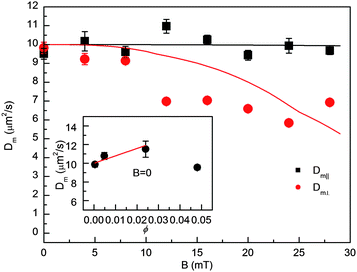 | ||
| Fig. 5 The diffusion constant of magnetic nanoparticles as a function of the external field. The lines are theoretical predictions from the theory of Morozov (see text) for 10 times larger interaction parameters than the one calculated from the material parameters. Inset: The dependence of the diffusion constant of magnetic nanoparticles on the volume fraction in the absence of the field. The line is the linear fit to the data. | ||
While in ferrofluids the third term is negative and even in the absence of the field it accounts for the magnetic interaction, in the case of the paramagnetic particles there is no magnetic interaction in the absence of the field. In the inset in Fig. 5 the dependence of the diffusion constant on the volume fraction in the absence of the field is shown. For lowest three volume fractions, a linear fit gives (κT − κF) = 7.9 ± 3.9, which is in agreement with the properties of the surfactant SDS, which has negatively charged groups at the ends, which makes the system, in the absence of the field, repulsive. The diffusion constant of the most concentrated sample deviates from linear behavior, which is probably due to some aggregation of the particles.
The observed changes are larger than those predicted by the theory, the same size of changes of the diffusion constant in 30 mT can only be obtained in the theory if we take the magnetic interaction between the particles ten times larger than the one calculated from the material parameters (Fig. 5). With this theory we cannot reproduce the shape of the dependence of the diffusion constant on the external field.
The slow process we attribute to the formation of the chains of the particles in the external field. The dependence of its relaxation rate as a function of the external field is shown in Fig. 6. The average relaxation rate in the direction perpendicular to the field decreases with the field and at higher field is by a factor of 100 smaller. The slow relaxation also gets broader with increasing field, i.e., the stretching exponent decreases from 0.6 in low fields to 0.35 in higher fields. In the parallel direction, the relaxation rate slightly increases with the field and the stretching exponent does not show any significant field dependence. Its value is around 0.64.
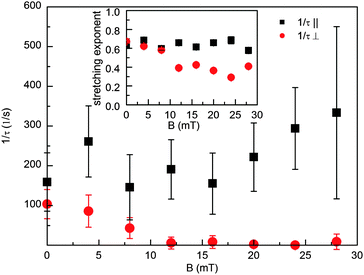 | ||
| Fig. 6 The relaxation rate of the slow process as a function of applied external field at a scattering vector of 8.1 × 106 m−1. Inset: the stretching exponent. | ||
Our samples in a magnetic field did not show any aging effects on the timescale of several hours, which is typical for our microrheological experiment at a given field strength. We checked that by measuring the autocorrelation function in a constant external field for 5 h and apart from rearranging dynamics in the first hour the correlation function did not depend on time. There are rather large fluctuations of the slow relaxation rate but no overall decreasing trend, which would imply gradual growth of the chains.
Discussion
The microrheological measurements show that already in relatively small fields the magnetic colloid behaves as a viscoelastic fluid. The field dependence of the effective viscosity can be fitted by an approximate formula for a polydisperse ferrofluid from Ref. 8 | (5) |
Our measured value of the storage modulus is small and is below the resolution of a standard macrorheological measurement. The linear visco-elastic response of a ferrofluid similar to the polymer case has been proposed in Ref. 18. In the model, a characteristic time, τ1, is introduced, which in the polymer case is the time needed for that polymer to disentangle, in the case of a magnetic colloid, it turns out that this time is connected to the relaxation time of magnetization. For times smaller than the characteristic time, t ≪ τ1, the response of the system is viscoelastic of the Kelvin–Voigt type, while at larger times it is viscous. The time dependence of MSD in this model is
 | (6) |
In the described model, only one relaxation time of magnetization is taken into account and, consequently, the short time viscosity, η, in eqn (6) is independent of the field. The measured short time viscosity, however, is field dependent, which can be attributed to smaller particles, which do not form chains and have a relaxation time of magnetization of the order of α. The much larger long time viscosity is due to the chains, which cause relaxation of the magnetization on the timescale of τ1. The anisotropy of long time viscosity is consistent with the only measurements of anisotropy of macroviscosity,4 where viscosity along the field is also larger than the viscosity in the direction perpendicular to the field.
While Kelvin–Voigt material at zero frequency has a non-zero storage modulus, this is not the case for a material described by eqn (6), with a purely viscous response at low frequencies and, as such, it is not a gel. In our microrheological measurements, however, we probe local properties on the micrometre scale, which may differ from the macroscopic results.
In Ref. 18 the shear elastic coefficients for two of three cases are calculated, i.e., (‖) the external field is along the flow velocity and perpendicular to the flow gradient and (⊥) the external field is parallel to the flow gradient and perpendicular to the flow velocity. The shear constants in the two situations are proportional to the square of the field and their ratio is
 | (7) |
We can fit the field dependence of the measured effective shear moduli along and perpendicular to the field with a quadratic function, but from the coefficients we cannot obtain reasonable values for λ2 and χ. One of the reasons is that we measure the effective complex shear constants that are in a complicated way connected to the three complex shear constants, which correspond to the geometries described above. The problem is similar to calculating the drag force on a spherical particle in a nematic liquid crystal, i.e., calculating the effective viscosity the spherical particle feels when moving along or perpendicular to the nematic director. This problem has been treated theoretically20 and experimentally.21,22 Theoretical analysis has shown that, for a uniform nematic liquid crystal, the effective viscosities for the spheres are connected to the translational viscosities that correspond to (‖), (⊥) and (⊥⊥) geometries in a complicated way. We expect something similar for the complex effective shear constants. So although the qualitative agreement of our measurements with the theory is good, without detailed theoretical analysis of the forces on the spherical particle that moves through a ferrofluid, we cannot predict the dependence of Geff′ on λ2 and χ, that would enable us to determine their values from the experiments. For small λ2, however, the anisotropy, i.e., the ratio in eqn (7), is larger than 1, and that agrees with our experimental findings.
The broadening and slowing down of the slow process that we observe in the DLS experiments in the external field can be attributed to the growth of the chains and to the interaction between them. From the DLS experiment alone it is not possible to distinguish both contributions. The decrease of the stretching exponent can probably be attributed to an increase in the chain polydispersity, as in higher fields smaller particles also start to aggregate. However, some estimates of average chains' length can be made. The number density of the particles that form chains can be estimated for a given strength of the external field, if we assume that all particles for which the magnetic interaction exceeds thermal energy form chains. In the sample in 24 mT the critical radius above which particles form chains is around 100 nm. Using experimental size distribution of the particles we calculated that the number density of the particles larger than 100 nm is 2.2 × 1018 m−3 whereas the number density of smaller particles is 3.1 × 1021 m−3. From the ratio between the amplitudes of the fast and slow relaxation in the field autocorrelation function, which are proportional to the product of number density and scattering cross section of scatterers, and the experimental number distribution, we can estimate the average length of the chains. The intensity scattered by a chain of N particles of radius a in the direction perpendicular to the chain is proportional to N2a6. Taking into account the experimental distribution function and performing the appropriate averages, we obtain an estimate for the chain length of the order of 10 large particles with a mean radius of 170 nm, i.e., an average length of about 3.4 μm. The average lateral distance between the chains would be 1.2 μm and would be comparable to their length. Such chains should be barely visible by the microscope and from the observations we know that most of the chains are too small to be seen by the microscope. The chains, however, consist of polydispersed particles and so they are of different thicknesses and lengths, as is also suggested by the broad distribution of relaxation rates in the correlation function of the slow process. They are surrounded by diffusing magnetic nanoparticles that may screen the magnetic interaction between them and probably suppresses further growth of the chains with time as we observe no aging effects.
Free diffusion of a chain of 10 large particles would be an order of magnitude faster than is the relaxation rate of the slow process in the field of 24 mT, which is not surprising since the density of the chains is large enough to suppress free diffusion of the chains. And, as we also observe a jump in the diffusion constant of the small nanoparticles and a non-zero value of the storage moduli at the magnetic field at which the formation of the chains starts, the free diffusion of the chains is not only suppressed, but, at least locally, they start to form an anisotropic gel.
Conclusions
Our microrheological experiments show that the polydisperse magnetic colloid evolves from a viscous fluid in the zero-field to a viscoelastic gel when a strong enough external magnetic field is applied. The results of our study support the idea presented in Ref. 8, in which in the hydrodynamic theory for a polydispersed ferrofluid two timescales of relaxation of the magnetization are introduced. The fast relaxation corresponds to the small particles that do not form chains in an external field, while the slow relaxation accounts for the chains. At short times the linear response of the system is viscoelastic with a field-dependent viscosity that is isotropic and can be attributed to small particles and with a highly anisotropic shear storage modulus that originates in the formation of the chains. The long time behavior of the system is viscous, with the effective viscosity in the direction along the field larger than in the perpendicular direction. The long time viscosity is of an order of magnitude larger than the short time viscosity, which is in agreement with macroscopic rheological experiments, which showed a large magnetoviscous effect only in chain-forming ferrofluids. Additionally, our study shows that the origin of the anisotropy of viscoelastic properties is also in the formation of the chains. It still remains a challenge to measure anisotropy of rheological properties in the non-linear response where shear thinning is observed.Acknowledgements
A. M. and M. Č. acknowledge the support from Ministry of Higher Education, Science and Technology of Slovenia (Grant No. P1-0192).Notes and references
- For a recent review see, Colloidal Magnetic Fluids, ed. S. Odenbach, Springer Verlag, Berlin Heidelberg, 2009 Search PubMed.
- R. E. Rosensweig, Ferrohydrodynamics, Dover, Mineola, 1997 Search PubMed.
- S. Odenbach, Ferrofluids, Springer Verlag, Berlin, 2002 Search PubMed.
- J. P. McTague, J. Chem. Phys., 1969, 51, 133 CAS.
- S. Odenbach, J. Phys.: Condens. Matter, 2004, 16, R1135 CrossRef CAS.
- L. M. Pop and S. Odenbach, J. Phys.: Condens. Matter, 2006, 18, S2785 CrossRef CAS.
- P. Ilg, M. Kröger and S. Hess, Phys. Rev. E: Stat., Nonlinear, Soft Matter Phys., 2005, 71, 051201 CrossRef.
- S. Mahle, P. Ilg and M. Liu, Phys. Rev. E: Stat., Nonlinear, Soft Matter Phys., 2008, 77, 016305 CrossRef.
- H. Shahnazian and S. Odenbach, J. Phys.: Condens. Matter, 2008, 20, 204137 CrossRef.
- A. Mertelj, L. Cmok and M. Čopič, Phys. Rev. E: Stat., Nonlinear, Soft Matter Phys., 2009, 79, 041402 CrossRef.
- R. Blaak, M. A. Miller and J.-P. Hansen, Europhys. Lett., 2007, 78, 26002 CrossRef.
- For a recent review see, T. M. Squires and T. G. Mason, Fluid Mechanics of Microrheology, Annu. Rev. Fluid Mech., 2010, 42, 413 Search PubMed.
- Thomas G. Mason, Rheol. Acta, 2000, 39, 371 CrossRef CAS.
- S. Gyergyek, M. Huskić, A. Mertelj, D. Makovec and M. Drofenik, Colloids Surf., A, 2010, 366, 113 CrossRef CAS.
- S. Jabbari-Farouji, M. Atakhorrami, D. Mizuno, E. Eiser, G. H. Wegdam, F. C. MacKintosh, Daniel Bonn and C. F. Schmidt, Phys. Rev. E: Stat., Nonlinear, Soft Matter Phys., 2008, 78, 061402 CrossRef CAS.
- K. I. Morozov, J. Magn. Magn. Mater., 1993, 122, 98 CrossRef.
- J. C. Bacri, A. Cebers, A. Bourdon, G. Demouchy, B. M. Heegard, B. Kashevsky and R. Perzinsky, Phys. Rev. E: Stat. Phys., Plasmas, Fluids, Relat. Interdiscip. Top., 1995, 52, 3936 CrossRef CAS.
- O. Müller, D. Hahn and M. Liu, J. Phys.: Condens. Matter, 2006, 18, S2623 CrossRef.
- H. W. Müller and M. Liu, Phys. Rev. E: Stat., Nonlinear, Soft Matter Phys., 2001, 64, 061405 CrossRef CAS.
- H. Stark and D. Ventzki, Phys. Rev. E: Stat., Nonlinear, Soft Matter Phys., 2001, 64, 031711 CrossRef CAS.
- J. C. Loudet, P. Hanusse and P. Poulin, Science, 2004, 306, 1525 CrossRef CAS.
- A. A. Verhoeff, J. van Rijssel, V. W. A. de Villeneuve and H. N. W. Lekkerkerker, Soft Matter, 2008, 4, 1602 RSC.
| This journal is © The Royal Society of Chemistry 2011 |
